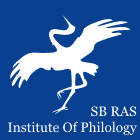 |
|
||||||||||||
|
Institute of Philology of
the Siberian Branch of Russian Academy of Sciences |
|
||||||||||||
|
|||||||||||||
| Sibirskii Filologicheskii Zhurnal (Siberian Journal of Philology) | |
|
Article
Authors: Svetlana V. Androsova Amur State University, Blagoveshchensk, Russian Federation In the section Linguistics
Abstract: Linguistic creativity (LC) is an inherent feature of language, constantly used by individual and collective native speakers for various purposes. This paper examines the contributions of Russian and foreign linguists to the study of LC, focusing on its essence and diverse manifestations across different genres and linguistic levels. The analysis explores phonetic data collected by the author and collaborators, with illustrative examples taken from Russian, English, Chinese, and Pashto. Analytical, synthetic, and observational methods were employed to summarize the findings and elucidate both conscious and unconscious LC. The results of structural-semantic and contextual analyses indicate that LC cannot be considered solely the domain of writers and poets. Concurrent generative and lexical creativity processes facilitate the generation of linguistic units within spontaneous conversational contexts. For example changing just one word in a common proverb can completely alter its meaning. Both specialized and general language communities produce significant jargon, while global events foster the emergence of neologisms with varying lifespans. Global occurrences foster the development of neologisms with varying lifespans. A notable illustration is the COVID-related neologisms that originated in Chinese and quickly spread into other languages. Acoustic analysis revealed a predominance of non-canonical, or weak, phonetic forms resulting from assimilations, omissions, and liaisons. While these forms may appear chaotic, they reflect the complex coordination that governs speech production and perception. In conclusion, it can be stated that LC is an inherently elusive phenomenon, posing significant challenges to precise measurement and necessitating further investigation. Keywords: F-creativity, E-creative, professional and casual communication, speech production, speech perception, non-canonical patterns Bibliography: Adger D. Language unlimited: The science behind our most creative power. Oxford, Oxford Uni. Press, 2019, 263 p. Ageev S. V., Antonenko N. V., Pushkarev E. A. O kognitivno-pragmaticheskom funktsionirovanii neologizma [Cognitive and pragmatic functions of neologisms in speech] Theoretical and Applied Linguistics. 2020, iss. 6, no. 2, pp. 5–17. DOI 10.22250/2410-7190_2020_6_2_5_17 Androsova S. V. Nekanonicheskie fonologicheskie modeli morfem i slov v russkom i angliiyskom yazykakh [Non-canonical models of morphemes and words in Russian and English]. Theoretical and Applied Linguistics. 2015, iss. 1, no. 1, pp. 5–15. Anishchenko O. A., Abutalipova B. M. Pandemiya koronavirusa: novye russkie i kazakhskie slova v leksikone kazakhstantsev [Coronovirus Pandemic: New Russian and Kazakh words in the Kazahk vocabulary]. In: Novye slova i slovari novykh slov. 2020 [New words and dictionaries of new words]. N. V. Kozlovskaya (Ed.). St. Petersburg, IWL RAS, 2020, pp. 28–32. Asoulin E. The Creative aspect of language use and the implications for linguistic science. Biolinguistics. 2013, vol. 7, pp. 228–248. URL: http://www.biolinguistics.eu (accessed 12.02.2024). Bergs A. What, If Anything, Is Linguistic Creativity? Gestalt theory. 2019, vol. 41, no. 2, pp. 173–184. DOI 10.2478/gth-2019-0017 Borankulova B. E., Proshina Z. G. New vocabulary related to coronavirus: The potential of its use in the Kazakh language and the problem of translation. Theoretical and Applied Linguistics. 2021, vol. 7 (3), pp. 18–25. DOI 10.22250/2410-7190_2021_ 7_3_18_25 Carter R. Language and Creativity: The Art of Common Talk. 2nd ed., Routledge, 2015, 288 p. Chomsky N. Current Issues in Linguistic Theory. The Hague, Mouton, 1964, 119 p. Cremin T., Maybin J. Children and teachers’ creativity in and through language. In: International Research Handbook of Children’s Literacy, Learning and Culture. K. Hall, T. Cremin, B. Comber, L. Moll (Eds.). Wiley Blackwell, 2013, pp. 1–19. URL: https:// www.researchgate.net/publication/269699424_Language_and_Creativity (accessed 12.02.2024). Gekkina E. N. Kovid versus koronavirus: iz nablyudeniy za regulyarnymi sluchayami derivatsionnykh razlichiy [Covid vs coronavirus: Observations over derivational differences]. In: Novye slova i slovari novykh slov. 2020: Sb. nauch. st. [New words and dictionaries of new words. 2020: Coll. of sci. art.]. N. V. Kozlovskaya (Ed.). St. Petersburg, IWL RAS, 2020, pp. 148–156. Gromenko E. S. “Koronnyy” potentsial russkogo yazyka nachala 2020 g. [“Corona’s” potential of Russian in early 2020s]. In: Novye slova i slovari novykh slov. 2020: Sb. nauch. st. [New words and dictionaries of new words. 2020: Coll. of sci. art.]. N. V. Kozlovskaya (Ed.). St. Petersburg, IWL RAS, 2020, pp. 45–62. Ishchenko I. G., Filonova O. S. Semanticheskiy aspekt angliyskikh neologizmov s gendernym komponentom znacheniya [Semantic aspect of English neologisms with gender component in meaning]. Theoretical and Applied Linguistics. 2020, iss. 6, no. 4, pp. 74‒83. DOI 10.22250/2410-7190_2020_6_4_74_83 Lederer R. Tvorchestvo chelovecheskogo yazyka [Creativity of human language]. Language. 2019. URL: https://www.languagemagazine.com/2019/06/10/the-creativity-of-human-language/ (accessed 12.02.2024). Li Y. Akusticheskie kharakteristiki slabykh form kitayskikh slov [Acoustic patterns of Chinese weak word forms]. South Ural State University Bulletin. Series “Linguistics.” 2021, vol. 18, no. 2, pp. 74–80. DOI 10.14529/ling210212 Li Y., Androsova S. V. Foneticheskie osobennosti slov v ikh obychnykh funktsiyakh i v kachestve slov-parazitov (na materiale kitayskogo yazyka) [Phonetic patterns of words in their ordinary functions and as parasite words (Based on Chinese)]. Theoretical and Applied Linguistics. 2019, iss. 5, no. 3, pp. 99‒116. DOI 10.22250/ 2410-7190_2019_5_3_99_116 Li X., Starodubtseva N. S. Lozungi na rabotakh masterov nematerial’nogo kul’turnogo naslediya Kitaya kak sredstvo bor’by s epidemiey koronavirusnoy infektsii (COVID-19) [Slogans on the works of masters of China’s intangible cultural heritage as a means of combating the epidemic of coronavirus infection (COVID 19)]. Theoretical and Applied Linguistics. 2021, vol. 7, no. 3, pp. 116–130. DOI 10.22250/2410-7190_2021_7_3_116_130 Lingvistika kreativa [Linguistics of creativity]. Gridina T. A. (Ed.). Ekaterinburg, UrSPU, 2018, 367 p. Lingvokreativnost’ v diskursakh raznykh tipov: Predely i vozmozhnosti [Linguistic creativity in various types of discourse: Limitations and possibilities]. Zykova I. V. (Ed.). Moscow, R. Valent, 2021, 564 p. Pavlova A. S. Naimenovaniya koronavirusnoy infektsii COVID-19 v russkom, angliyskom i nemetskom yazykakh: kul’turno-natsional’naya spetsifika [Coronovirus COVID-19 infection names in Russian, English and German: Cultural and nationa specifics]. In: Novye slova i slovari novykh slov. 2020: Sb. nauch. st. [New words and dictionaries of new words. 2020: Coll. of sci. art]. N. V. Kozlovskaya (Ed.). St. Petersburg, IWL RAS, 2020, pp. 126–138. Prokof’eva N. A., Shcheglova E. A. Mediaslovar’ klyuchevykh slov tekushchego momenta: leksiko-semanticheskoe pole “koronavirus” [Media dictionary of keywords of the present moment: Lexical-semantic field “Coronavirus”]. In: Novye slova i slovari novykh slov. 2020: Sb. nauch. st. [New words and dictionaries of new words. 2020: Coll. of sci. art]. N. V. Kozlovskaya (Ed.). St. Petersburg, IWL RAS, 2020, pp. 190–202. Raevskaya O. V. Avtorskaya markirovannost’ nauchnogo teksta, avtorskiy stil’ i blagorodnyy pafos uchenogo [Author style of a research paper and the researcher’s noble pathos]. In: Sbornik nauchnykh i uchebno-metodicheskikh trudov. Vyp. 20 v chest’ Yubileya professora Svetlany Grigor’evny Ter-Minasovoy [Collection of Academic and Scientific Works, iss. 20: In Honor of Professor Svetlana Grigor’evna Ter-Minasova]. S. V. Titova, S. G. Ter-Minasova, M. G. Bakhtiozina (Eds.). Moscow, KDU, Dobrosvet, 2023, pp. 173–181. URL: https://bookonlime.ru/node/56039 (accessed 12.02.2024). Shamina E. A. Foneticheskaya motivirovannost’ kak osnovanie literaturnogo slovotvorchestva (na materiale skazki R. Dala “The BFG”) [Phonetic motivation as a foundation for literary neologisms (Based on R. Dahl’s fairy tale “The BFG”)]. Theoretical and Applied Linguistics. 2015, iss. 1, no. 4, pp. 85–98. Sharapkova A. A. Kreativnye nazvaniya nauchnykh statey: voprosy klassifikatsii i kontseptual’nyy analiz [Creative titles of research papers: Classification issues and conceptual analysis]. In: Sbornik nauchnykh i uchebno-metodicheskikh trudov. Vyp. 20 v chest’ Yubileya professora Svetlany Grigor’evny Ter-Minasovoy [Collection of Academic and Scientific Works, iss. 20: In Honor of Professor Svetlana Grigor’evna Ter-Minasova]. S. V. Titova, S. G. Ter-Minasova, M. G. Bakhtiozina (Eds.). Moscow, KDU, Dobrosvet, 2023, pp. 347–364. URL: https://bookonlime.ru/node/56039 (accessed 12.02.2024). Shustova S. V., Shipitsin A. A. Novaya leksika v diskursivnoy praktike “kul’tury otmeny” [New vocabulary in the discursive practice of ‘Сancel Сulture’]. Theoretical and Applied Linguistics. 2023, iss. 9, no. 3, pp. 203–217. Sakakini A., Hadi D. Creativity in language: Reflections on polysemy, metaphors, idioms, collocations... and the like. BAU Journal – Society, Culture and Human Behavior. 2019, vol. 1, iss. 1, article 1. URL: https://digitalcommons.bau.edu.lb/ schbjournal/vol1/iss1/1 (accessed 12.02.2024). Sampson G. Two ideas of creativity. In: Evidence. Experiment and argument in linguistics and philosophy of language. M. Hinton (Ed.). Bern, Peter Lang, 2016, pp. 15–26. Streke Ya. V., Androsova S. V. Weak forms of words in socio-political discourse (Based on female speech). In: Proc. of the 13th Far Eastern English Language Teachers’ Association International Conference “Language Studies and Language Teaching: Dreams, hopes, aspiration, achievement”. S. V. Androsova (Ed.). Blagoveshchensk, Amur State Univ. Press, 2021, pp. 107–112. DOI 10.22250/LsLt.2021.107_112 Thorne T. #CORONASPEAK – the language of Covid-19 goes viral. URL: language-and-innovation.com/2020/04/15/coronaspeak-part-2-the-language-of-covid-19-goes-viral/ (accessed 15.01.2020). Vasina K. S., Te O. E. Neologizmy v obshchestvenno-politicheskikh tekstakh na kitayskom yazyke v period pandemii koronavirusa (COVID-19) [Neologisms in socio political texts in Chinese during the coronavirus (covid-19) pandemic]. Theoretical and Applied Linguistics. 2021, iss. 7, no. 4, pp. 16–28. DOI 10.22250/2410-7190_2021_ 7_4_16_28 Yanurik S. Neologizmy koronavirusnoy epokhi v russkom i vengerskom yazykakh: sopostavitel’nyy aspekt [New words of coronavirus era in Russian and Hungarian]. In: Novye slova i slovari novykh slov. 2020 [New words and dictionaries of new words]. N. V. Kozlovskaya (Ed.). St. Petersburg, IWL RAS, 2020, pp. 210–218. Zamaldinov V. E. Kreativnyy neyming nizhegorodskikh zavedeniy obshchestvennogo pitaniya: graficheskiy aspekt [Creative naming of Nizhny Novgorod public catering establishments: Graphic aspect]. Theoretical and Applied Linguistics. 2021, iss. 7, no. 2, pp. 35–43. DOI 10.22250/2410-7190_2021_7_2_35_43 Zawada B. Linguistic creativity from a cognitive perspective. Southern African Linguistics and Applied Language Studies. 2006, no. 24 (2), pp. 235–254. |
 |
Institute of Philology Nikolaeva st., 8, Novosibirsk, 630090, Russian Federation +7-383-330-15-18, ifl@philology.nsc.ru |
© Institute of Philology |


